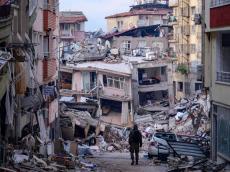|
|
TODAY.AZ / Politics
Devastating earthquakes in Turkiye and Syria: geological features and analysis
23 February 2023 [11:34] - TODAY.AZ

The world has suffered a lot in recent times. The region of southeast Turkiye and Syria is considered one of the most active seismic zones in the world, and the event on February 6 added to the long list of earthquakes. Two earthquakes of magnitude 7.8 and 7.5, together with their aftershocks, have caused chaos and thousands of deaths in southeastern Turkiye and northern Syria.
Over the past century, 50 strong aftershocks have occurred in this region.
Until now, the most serious earthquake in recent history was considered the one that occurred in 1939 in the province of Erzincan, which killed 32,000 people.
Speaking about what happened in Kahramanmaras on February 6, Turkish President Recep Tayyip Erdogan said that this is the biggest tragedy in the country after the aforementioned earthquake in Erzincan.
The reason for this seismic activity is that four tectonic plates converge in this territory: Anatolian, Arabian, Eurasian, and African. These massive plates that form the outer layer of our planet are constantly shifting and colliding with each other.

Earthquakes most often occur along fault lines that cause cracks in the planet's surface. And in this region, there are two large transform faults, that is, those in which there is a lateral displacement of one tectonic plate in relation to another: the North Anatolian fault (1000 km long) and the Eastern Anatolia fault (700 km).
When tectonic plates collide with each other, they can get stuck due to friction. At the moment of the final "sticking off" as a result of increasing pressure, they release a large amount of energy, which is subsequently revealed on the surface in the form of earthquakes or, in the case when tectonic plates converge underwater, a tsunami.
In addition, the tectonic plates in the area are shifting laterally with respect to each other. In particular, the Arabian Plate is moving north at a rate of about two centimeters per year, while the African Plate is moving in the same direction but at a slower rate. This kind of displacement causes more frequent and also stronger earthquakes.
As the earth's crust adjusts to the changes, numerous aftershocks occur after a major earthquake. For this reason, three more earthquakes of magnitude over 6.0 were recorded in Turkiye in the first twelve hours after the initial shock, the first of which, with a magnitude of 6.7, occurred just 11 minutes after the first earthquake. Further, hundreds more aftershocks of smaller magnitude were observed.
One of the regions most similar to Turkiye and Syria is Japan, as there, in the Pacific Ocean, four tectonic plates converge. An event in 2011 triggered one of the strongest and most dangerous earthquakes in recent memory, which turned into a catastrophic tsunami that swept the northeast coast of Japan and caused the nuclear tragedy at Fukushima.
URL: http://www.today.az/news/politics/231977.html
 Print version
Print version
Connect with us. Get latest news and updates.
See Also
- 28 August 2025 [10:10]
And who’s back there again? Konstantin Zatulin once more. - 27 August 2025 [11:27]
President: The biggest threat to the Muslim world is sectarian division - 27 August 2025 [10:46]
Zangazur Corridor not to be East-West, but also North-South transportation corridor - President - 27 August 2025 [10:13]
President Ilham Aliyev gave interview to Al Arabiya TV channel - 27 August 2025 [10:10]
Pashinyan told the Armenians what Azerbaijan has been saying for a long time - 25 August 2025 [15:16]
ANAMA: Nearly 1,500 hectares made safe in demining push - 25 August 2025 [14:14]
Radicals have invented new enemy for Iran - 25 August 2025 [14:12]
Research Center: Peace agreement opens historic new page for S Caucasus - 25 August 2025 [13:02]
Human remains discovered in liberated A?d?r? district - 25 August 2025 [12:04]
President Ilham Aliyev receives UK Minister of State for Europe and North America
Most Popular
 Radicals have invented new enemy for Iran
Radicals have invented new enemy for Iran
 Research Center: Peace agreement opens historic new page for S Caucasus
Research Center: Peace agreement opens historic new page for S Caucasus
 President Ilham Aliyev receives UK Minister of State for Europe and North America
President Ilham Aliyev receives UK Minister of State for Europe and North America
 Human remains discovered in liberated A?d?r? district
Human remains discovered in liberated A?d?r? district
 ANAMA: Nearly 1,500 hectares made safe in demining push
ANAMA: Nearly 1,500 hectares made safe in demining push
 Court in Baku continues trial of Armenian-origin individuals accused of war crimes
Court in Baku continues trial of Armenian-origin individuals accused of war crimes
 Azerbaijan to purchase medicines for vulnerable patient groups
Azerbaijan to purchase medicines for vulnerable patient groups
